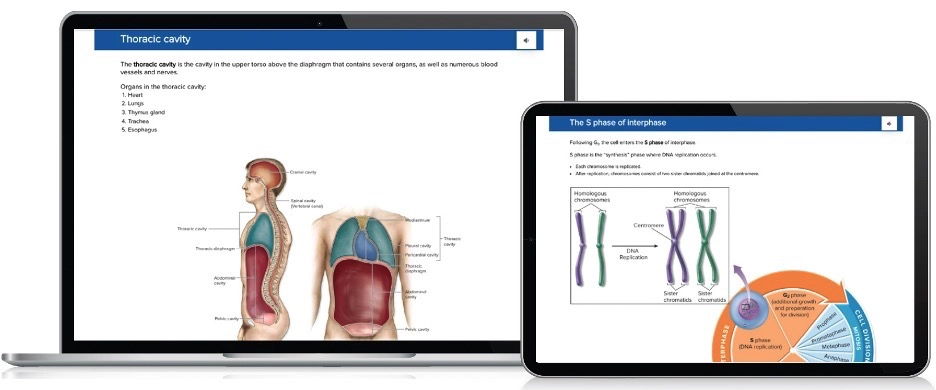Underprepared Students? Now You Can Level the Playing Field
Students entering into Anatomy & Physiology courses often have gaps in understanding core biology concepts. A&P Prep helps fill in those gaps.
Listen for more on the topic of underprepared students on the Succeed in A&P Podcast: Prepare Your Students for A&P. Stop the Drop!
If you ever find yourself stuck at a party talking with a college professor, I highly recommend you avoid the topic of student preparedness. This is especially true if you find yourself stuck with one of my fellow Anatomy and Physiology professors! Faculty across disciplines often bemoan the academic state of their current students, but A&P professors find themselves acutely aware of the student's academic deficiencies. In my many conversations with other A&P faculty, I have encountered frustration, exasperation, and the repeated question of “what am I supposed to do?”
As our understanding of the human body progresses to include molecular and genetic physiology, the amount of scientific understanding our students need to be successful has increased. Tasked with teaching complex scientific material to aspiring nurses, physical therapists, and doctors early in their post-secondary academic careers, A&P professors frequently lash out when student preparedness comes up in conversation. I am certain your party friend will give you a rant you will never forget!
There is a simple fix to our preparation problem, but it is often infeasible: add pre-requisites for A&P courses. A general biology class covers the basics of genetics, biological molecules, and chemistry needed as a foundation for understanding many physiological processes. As universities nationwide try to reduce the number of hours it takes to get a degree, baccalaureate nursing programs reduced the number of pre-requisite classes they require. Absent requirements to take college-level biology courses, many students enter our A&P classes with a surface understanding of principles that will drastically influence their ability to succeed. The task of preparing students for A&P falls squarely on the students themselves and their A&P professors and instructors.
As an instructor, I feel an obligation to prepare my students the best I can. I have tried various methods to remediate my students’ deficiencies with varying degrees of success. I have forced students to talk to me during office hours by not giving back exams. This was more effective with smaller classes but in larger lectures (200+ students), it is impossible to spend enough time with each student to determine what help they need. Like many other professors, I have devoted about a quarter of my lecture time during A&P I to covering materials that would normally be covered in general biology. Though effective, this particular fix takes away precious in-class time that would be better used to talk about A&P-specific material. It is also particularly bothersome to those students who are not nursing majors and have taken several previous courses that focus on the background information. Over time, I learned that what I needed was the ability to target specific students in regard to specific preparatory material in which they were deficient. I finally found the tool I had been searching for...
[Insert dramatic music of your choice; as a proud nerd, I choose the Imperial March from Star Wars]
When I first saw Connect, and in particular A&P Prep (formerly LearnSmart Prep), I remember feeling that excitement you get when some major pedagogical idea you have been working towards finally clicks. I had longed for a tool to help me reach my students where they were. For many of them, their lack of preparedness is not a sign of their attitude towards scholarship or a signal of their ability to learn. Instead, it is a product of their situation; in particular, their academic youth when taking the course and a system that pushes them into a course without the proper pre-requisites. Employing Prep at the beginning of the semester can allow the instructor to find the students who need remediation early—regardless of class size. The adaptive nature of Prep, in combination with the data collected by Connect and available to both the faculty member and the student, enables me to strike the balance I have always wanted. I now know what specifically confounds a particular student by checking their progress on Prep or I can see what tends to be a difficult topic for the class as a whole.
Most importantly, the student is aware of what they do not know.
A&P Prep was recently updated with new topics and more accessible technology in Spring of 2021. Updates include not only the pre-course preparation modules (Science of Biology, Chemistry of Life, Cell Structure & Function, DNA Biology, Body Orientation, Fundamentals of Math, Fundamental Skills for the Scientific Library and Fundamentals of Student Success), but also A&P in-course prep topics that you can assign to ensure students are ready to move on from each module in the course. Listen more here to learn more about these updates!
There are several features worth noting…
- The interface is intuitive and helps any person move through the assignment, even the most digitally naïve.
- The questions are mobile-friendly, and I frequently see students sitting in the hallway before lab working through the assignments during a spare moment.
- Feedback is instantaneous, which helps students realize where they can focus their efforts more quickly.
- Finally, the reports generated act as excellent jumping-off points when a student comes to my office for help. I do not have to spend precious time playing 20 questions with them to figure out where they are tripping up. I simply pull up their Prep report and we can discuss the specific topics with which they struggle. The student and I both appreciate the advantage Prep gives us during the early semester meetings.

How does it work?
Students answer questions tied to key course learning objectives. Based on several factors (including how students answer the question and their confidence level) Prep quickly identifies the challenges a student is struggling with and provides them with learning resources (such as videos, applicable reading material, simulations, etc.) to master those concepts.
Assign A&P Prep in 3 Easy Steps within Connect:
- Click “Add Assignment”
- Select “Adaptive Learning Assignment”
- Click on “New Assignment” and “A&P Prep”
I truly believe that teaching college is an honor. I enjoy my job; I get to meet great people and have the chance to influence them to become lifelong learners. The challenge of dealing with students, who come from different backgrounds both socially and academically, is not going to go away. However, the use of adaptive tools like A&P Prep and SmartBook makes the task of reaching those students early and often more attainable no matter the class size.
